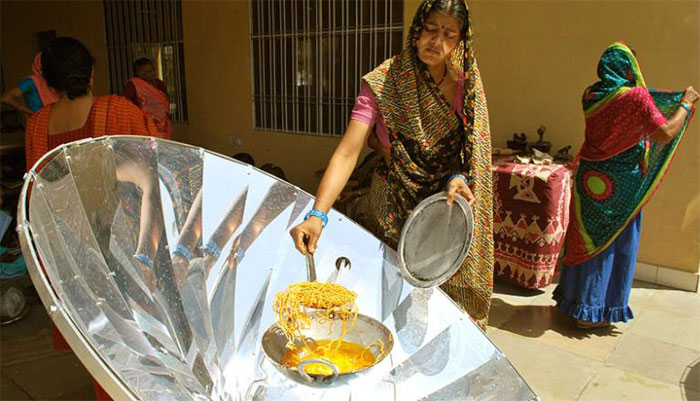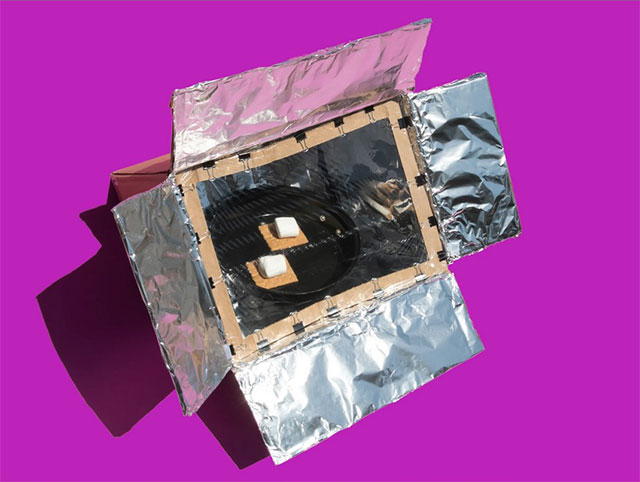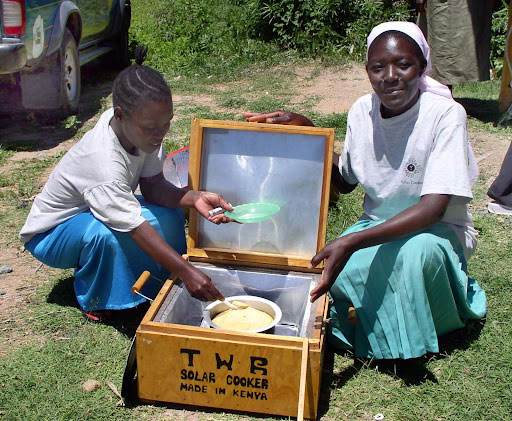From the chilly, misty mountains of Europe to the humid forests of Central Asia and the arid regions of Africa, millions of people are cooking with a special type of stove.
CNN reports that this miraculous stove is called a solar cooker. Instead of using gas, electricity, or firewood, the solar cooker utilizes reflective surfaces to concentrate sunlight into a small area, generating heat to cook food without producing any polluting emissions.

Solar cooker used in Madhya Pradesh, India. (Photo: CNN)
Simple and Cost-Effective
There are many types of solar cookers, ranging from box cookers to rooftop systems and vacuum tube cookers, which are more complex devices that work in colder climates. To create the most basic type, you only need a few inexpensive and readily available materials to make a safe and effective solar cooker.
The maximum temperature that this cooker can reach is about 93 degrees Celsius, sufficient for cooking sausages, bacon, and more. The main materials needed include a few cardboard boxes, a mirror, or a metal sheet costing only a few USD.
The cardboard box should measure 30-38 cm in length. Additionally, you will need aluminum foil, a pan, insulating materials such as newspapers, foam, cling film, tape, and a kitchen thermometer. First, seal the bottom and edges of the cardboard box, leaving the lid open. Use aluminum foil to wrap the foam pieces and insert them into the corners of the box.

DIY solar cooker made from simple materials. (Photo: Wired)
The aluminum foil helps distribute the heat from sunlight throughout the inside of the box, enhancing heating efficiency. Next, attach aluminum foil to the lid of the cardboard box. The user will adjust the lid to direct sunlight inside.
The cook will place food containers such as pans or metal plates inside the cardboard box. Dark-colored utensils are more suitable than light-colored ones as they help retain heat longer. The next step is to cover the open space of the box with cling film. This “barrier” is crucial as it allows sunlight to enter the box while “locking” in the heat.
Despite its simplicity, a downside is that the solar cooker cannot be used at night. Of course, on sunny days, food can cook quickly, while in bad weather, the solar cooker will require more time than conventional stoves or ovens to reach safe cooking temperatures.
However, under cloudy conditions, the solar cooker can still be used to dry food for longer preservation. According to the NGO SolarAid, in dry and sunny climates, a solar cooker can help save a ton of wood each year. The best conditions for this cooking method are on hot sunny days with the sun positioned optimally.
Contributing to Environmental Protection
According to the World Health Organization (WHO), approximately 2.6 billion people worldwide cook daily using wood, charcoal, animal waste, kerosene, and other materials that emit a lot of smoke, leading to deforestation, soil erosion, and desertification. In this context, solar cookers can be a useful alternative.
The nonprofit Solar Cookers International (SCI) states that there are currently 4 million solar cookers worldwide serving 14 million people. This means preventing 5.8 million tons of CO2 from being released into the environment each year. Janak Palta McGilligan, a member of the global advisory council of SCI in Madhya Pradesh, India, emphasizes the impact.

Solar cooker in Kenya. (Photo: solarcooking.org)
Living in a country where 81% of the rural population uses polluting materials for cooking, McGilligan observes that people are disadvantaged as natural wood resources diminish. Additionally, women cooking in enclosed spaces expose themselves and their families to the risks of respiratory infections.
The use of polluting materials for cooking accounts for over 50% of global black carbon emissions. Black carbon is one of the main contributors to climate change, second only to CO2, but it only remains in the atmosphere for a few days to weeks. In fact, burning biomass (materials derived from living organisms, such as straw and wood) produces significant CO2 emissions.
Moreover, the use of biomass contributes to deforestation in many rural areas. McGilligan states, “The Earth is at risk. In rural India, we cannot plant trees fast enough to compensate for the amount of wood used in cooking.”
She further shares, “The villagers have a connection to the forest. They feel regret if the forest is lost and there are no more trees. Solar thermal energy has alleviated their worries. The forests will be saved through the use of solar cookers.” With about 300 sunny days each year, India has sustainable opportunities for utilizing solar thermal energy.

















































